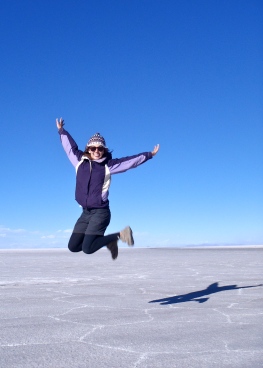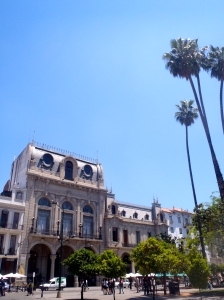I am finally HEALTHY!
It was awful being sick for 3 days, especially since I was scheduled for a 3 day Salt Flat tour, but everything turned out great. We met Sebastian, a 26 year old German physicist in Potosi, Bolivia and have been traveling for over a week before separating two days ago. The three of us went on the Salar de Uyuni tour, which boasted some amazing landscapes. There was a large group, so we had to go in two different jeeps. Stef, Sebastian and I ended up in a jeep with 4 sick Koreans and the other jeep had three Belgians and two drunk Aussies.
Our first day involved driving across the Salar, which is approximately 12000 square KM. Bolivian workers make 1bs. (less than 20 cents) per each salt pile they scrape… and these salt piles are quite large. They aim for 50 piles a day. It’s outrageous. Very few people in Canada would ever do that kind of manual labour.
The Salar itself is other-worldly. It looks like ice or snow for miles and miles – perfect for taking some funky photos. The second day of the tour was the most boring – 6 hours of driving through the desert. We saw a lot of volcanoes and lagoons – even some flamencos! The Koreans became much more sick and since Stef and I were squished in the very back of the jeep, we spent a good hour taking ridiculous photos of ourselves. The other jeep found a more interesting way to pass the time…. they bought two bottles of vodka/rum/whatever and got amazingly drunk. I think I would have puked because the ‘roads’ are awful.
The last day of the tour was rushed, but exciting. We drove up to 5000m above sea level and spent time at the world’s highest geysers – basically, steamy volcanic lava and ooze. I was a little scared since the ooze was bubbling half a metre away from me. After the geysers, we relaxed in a
natural hot spring. I’ve seen hot springs before, but I have never had the chance to swim in them. We piled back into the jeep and were dropped off at the Bolivian border. We said our goodbyes to the sick Koreans and the three of us got into a van to San Pedro de Atacama, Chile – the driest desert in the world.
We hung out in San Pedro for two days – mainly relaxing in hammocks. It felt like a beach town but with
no beach. Strange. On our last night, we went stargazing with a French astronomer in the desert. He had a telescope farm and after talking and examining the sky with the naked eye, we were able to look through all the telescopes at various space-scapes – including the moon, exploding stars, new star formations, the milky way, star clusters, and even the planet Jupiter.
We learned that there are 6000 stars you can see with the naked eye and that the closest star, called Alpha Santari, is 4.4 light years away. Apparently, there are 200 billion stars in our galaxy, which are all being charted with space instruments and there are over 100 billion galaxies, which are mostly bigger than our own. That’s an incredible amount of stars. Since our Sun is a star (and not even a large one!) the astronomer told us that most people in his field believe that there are other life forms in the universe, but that it could just be in the form of bacteria or maybe even in a larger scale……like ALIENS, or not. ha!
The astronomer was a quirky character and he did mention a few anti-religious claims that made some people uncomfortable – but all in all, I really liked him.
The next morning, we took a 12 hour bus to Salta, Argentina. Sebastian had already been in Salta and was moving on to Mendoza, so he only stayed one night while we stayed two. I was sad to part ways – we traveled well together and it was nice to have a guy around who could deter at least some of the jewelry making male hippies. haha.
For the most part, Stefanie and I just wondered around Salta. We shared a steak dinner from a street vendor for less than $5, bought fresh fruit, ate hotdogs and ice cream, and went shopping. I seriously needed another t-shirt. Backpacking destroys your clothes. Almost immediately, you notice the differences between Chile and Argentina and Peru and Bolivia. There are actually paved roads and street signs! Argentina is especially European. All around the main plaza, there were colonial buildings, palm trees and cafes. It was quite pretty in the centre.
Yesterday, I embarked on a 23 hour bus ride to Puerto Iguazu, which is 20 minutes from the infamous Iguazu Falls, bordering Brazil and Argentina. The bus ride was long, but tolerable. I think we are getting used to the long hours. Tomorrow, I am spending the whole day in the national park. I am also planning on taking a boat under the falls and going on a few hikes. It’s supposed to be spectacular!




Leave a comment